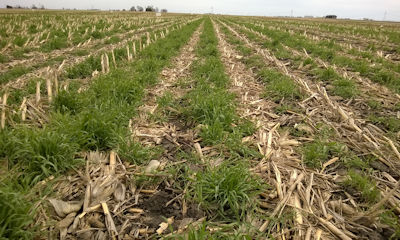
Adding cover crops to your operation is one of the many recommended Best Management Practices included in the Illinois Nutrient Loss Reduction Strategy. At a recent Illinois State University Department of Agriculture outreach meeting in Lexington, Shalamar Armstrong, assistant professor of agronomy at Purdue University, shared research on the relationship between cover crops, nitrogen utilization and ultimately, nutrient loss.

COVER CROP COMBO: Armstrong used daikon radish, cereal rye and a combination of the two in his research.
In a NREC funded tile-drain study conducted in 2014-2015, Armstrong found that using cover crops and applying nitrogen in the spring will keep nitrogen where it’s needed, until it’s needed. After 19 rain events, totaling 31 inches of rain, the results were pretty clear. “When you move that nitrogen application from fall to spring, you get a 15% reduction in nitrogen you lose out of the tile,” says Armstrong. “We found you get a 35% reduction when you add cover crops to fall-applied nitrogen, a 22% reduction when adding cover crops to spring-applied nitrogen and a 24% reduction for fall-applied N relative to spring-applied N without cover crops. There is no difference in nitrogen loss between spring and fall-applied N with cover crops.”
Related: Cover Crops: Best management practices
Adding cover crops protects your nitrogen investment and keeps nitrates out of the tile lines, Armstrong says. “That’s the kind of thought we need to move to. The next step is to get a better understanding of cover crop economics.”
The key takeaway on cover crop use: “It’s a pretty good idea.”

Shalamar Armstrong, assistant professor of agronomy at Purdue University
In a different study, Armstrong looked at weather, growing degree days, different cover crop species and nutrient uptake. The ultimate goal is to help farmers understand the potential return on their cover crop investment.
“For the past 5 years, adoption of cover crops in the Midwest increased by 188%. For the years before that, we can get the weather data and count GDD in the fall and predict what biomass we could have had. We can go forward and predict the uptake,” says Armstrong.
Related: Four considerations to get started cover cropping
“Why is that important? We want to try and put a dollar amount on how cover crops will pay off, and it will be dependent on GDD. We can use this information to predict how many years out of ten years cover crops will be profitable.”
Armstrong notes that cover crops are just part of the nutrient loss solution. “We have to come together. We can’t just study one side of the nitrogen management spectrum. We must study every aspect of nitrogen management, and we must study it well.”
Armstrong’s work is solid research that’s showing cover crops to be a solid investment in reducing nutrient loss.
About the Author(s)
You May Also Like




